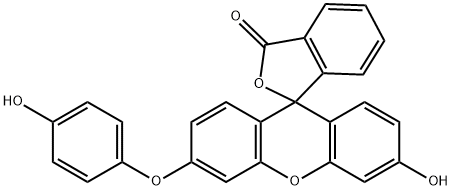The biology of highly reactive oxygen radical species is of great interest in many biomedical research disciplines, including neurodegeneration, aging, cancer, and infectious diseases. There are a number of fluorescent reagents, such as 2,7-dichlorodihydrofluorescein (DCDHF), that can be used to detect free radicals, but they have significant limitations due to their facile oxidation by light and numerous non-radical oxidants such as hydrogen peroxide (H2O2). HPF is a cell-permeable aromatic amino-fluorescein derivative that has little intrinsic fluorescence. It undergoes oxidation only by highly reactive oxygen species (hROS) such as the hydroxyl radical, peroxynitrite, and hROS generated from a peroxidase/H2O2 system. It is inert to hypochlorite ion, nitric oxide, hydrogen peroxide (H2O2), superoxide, and other oxidants. Upon oxidation, HPF is converted to the highly fluorescent molecule fluorescein, allowing the simple direct detection of highly reactive biological radicals.

